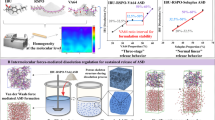Abstract
Pectins (Pec) of 33 to 74 % esterification degree were tested with doxorubicin (Dox), a very high toxic drug widely used in cancer therapies. Pec with 35 and 55 % DE were selected because of the Dox binding higher than Pec microspheres of 35 and 55 % obtained by ionotropic gelation with Ca+2 have 88 and 66 % Dox loading capacity. Kinetic Dox release showed more than 80.0 and about 30.0 % free drug from 35 % and 55 % Pec formulations at pH 7.4, and 37 °C after 1-h incubation, respectively. Besides, Dox release decrease to 12 % in 55 % Pec microsphere formulation after 1-year storage at 4 °C. FTIR analysis of Pec–Dox complex showed hipsochromic shifts for the σC=O, δN-H and σC-C vibrational modes compared to Dox spectrum suggesting strong interaction between the drug cargo and the matrix. Rheological studies of Pec and Pec–Dox samples flow behavior exhibited a shear-thinning nature. Fifty-five percent of Pec showed higher viscosity than the viscosity for 35 % Pec in all range of temperatures analyzed, and decreased when the temperature is raised. Besides, Pec–Dox complexes have higher viscosity values than those of the corresponding Pec samples, and viscosity curves as function of shear rate for 35 % Pec–Dox are above the curves of 55 % Pec–Dox. In both cases, the results are confirming significant interaction between the cargo and the matrix, which also was established in viscoelastic dynamic analysis.






Similar content being viewed by others
References
Williams, D. F. (2009). Biomaterials, 30, 5897–5909.
Liu, Z., Jiao, Y., Wang, Y., Ziyong, C., & Zhang, D. (2008). Advanced Drug Reviews, 60, 1650–1662.
Dornish, M., Kaplan, D., & Skaugrud, O. (2001). Annual New York Academy of Sciences, 944, 388–397.
Chi, H., Moturi, V., & Lee, Y. (2009). Journal of Controlled Release, 136, 88–98.
Peng, C., Zhao, Q., & Gao, C. (2010). Colloids and Surfaces A: Physicochemical and Engineering Aspects, 353, 132–139.
Nielsen, O. S., Reichardt, P., Christensen, T. B., Pink, D., Daugaard, S., Hermans, C., Marreaud, S., van Glabbeke, M., Blaye, J., & Judson, I. (2006). European Journal of Cancer, 42, 2303–2309.
Vrignaud, S., Anton, N., Gayet, P., Benoit, J. P., & Saulnier, P. (2010). European Journal of Pharmaceutics and Biopharmaceutics, 79, 197–204.
von Maltzahn, G., Park, J. H., Lin, K. Y., Singh, N., Schwöppe, C., Mesters, R., Berdel, W. E., Ruoslahti, E., Sailor, M. J., & Bhatia, S. N. (2011). Nature Materials, 10, 545–552.
Bockki, M., Jongbin, L., Sanghoon, K., Kwang-Geun, L., SungHo, L., & Suyong, L. (2011). Bioresource Technology, 102, 3855–3860.
Fraeye, I., Doungla, E., Duvetter, T., Moldenaers, P., Van Loey, A., & Hendrickx, M. (2009). Food Hydrocolloids, 23, 2069–2077.
Kumari, A., Yadav, S. K., & Yadav, S. C. (2010). Colloids and Surfaces. B, Biointerfaces, 75, 1–18.
Liechty, W. B., Kryscio, D. R., Slaughter, B. V., & Peppas, N. A. (2010). Annual Review of Chemical and Biomolecular Engineering, 1, 149–173.
Malam, Y., Loizidou, M., & Seifalian, A. M. (2009). Trends in Pharmacological Sciences, 30, 592–599.
Seo, S., Lee, C.-S., Jung, Y.-S., & Na, K. (2012). Thermo-sensitivity and triggered drug release of polysaccharide nanogels derived from pullulan-g-poly(l-lactide) copolymers. Carbohydrate Polymers, 87, 1105–1111.
Manchun, S., Dass, C. R., & Sriamornsak, P. (2012). Targeted therapy for cancer using pH-responsive nanocarrier systems. Life Sciences. doi:10.1016/j.lfs.2012.01.008.
Cai, H., Caihua Ni, C., & Zhang, L. (2012). Preparation of complex nano-particles based on alginic acid/poly[(2-dimethylamino) ethyl methacrylate] and a drug vehicle for doxorubicin release controlled by ionic strength. European Journal of Pharmaceutical Sciences, 45, 43–49.
Oh, J. K., Lee, D. I., & Park, J. M. (2009). Biopolymer-based microgels/nanogels for drug delivery applications. Progress in Polymer Science, 34, 1261–1282.
Karukstisu, K. K., Thompson, E. H. Z., Whiles, J. A., & Rosenfeld, R. J. (1998). Biophysical Chemistry, 73, 249–263.
Kayal, S., & Ramanujan, R. V. (2010). Materials Science and Engineering: C, 30, 484–490.
Purcell, J. M., & Fishman, M. L. (1987). Carbohydrate Research, 159, 185–190.
Lin-Vien, D., Colthup, N. B., Fateley, W. G., & Grasselli, J. G. (1991). The handbook of infrared and Raman characteristic frequencies of organic molecules. Boston: Academic.
Acknowledgments
The present work was supported by Consejo Nacional de Investigaciones Científicas y Técnicas (CONICET), and Agencia Nacional de Promoción Científica y Técnica (ANPCyT) of Argentina. We thank Dr. Paul Dumas (SMIS beam line, Soleil Synchrotron Facility, France) for his kind support and expertise during the sample analysis. We thank Mrs. Graciela Guananja from CPKelco (Buenos Aires, Argentina) for her kind help and the donation of pectin samples; and to Dr. Mario Malaspina (Laboratorio LKM S.A.) and Dr. Nicolas Martinez from Quality Pharma Laboratories for the doxorubicin samples used in the present work.
Author information
Authors and Affiliations
Corresponding author
Rights and permissions
About this article
Cite this article
Bosio, V.E., Machain, V., López, A.G. et al. Binding and Encapsulation of Doxorubicin on Smart Pectin Hydrogels for Oral Delivery. Appl Biochem Biotechnol 167, 1365–1376 (2012). https://doi.org/10.1007/s12010-012-9641-8
Received:
Accepted:
Published:
Issue Date:
DOI: https://doi.org/10.1007/s12010-012-9641-8




